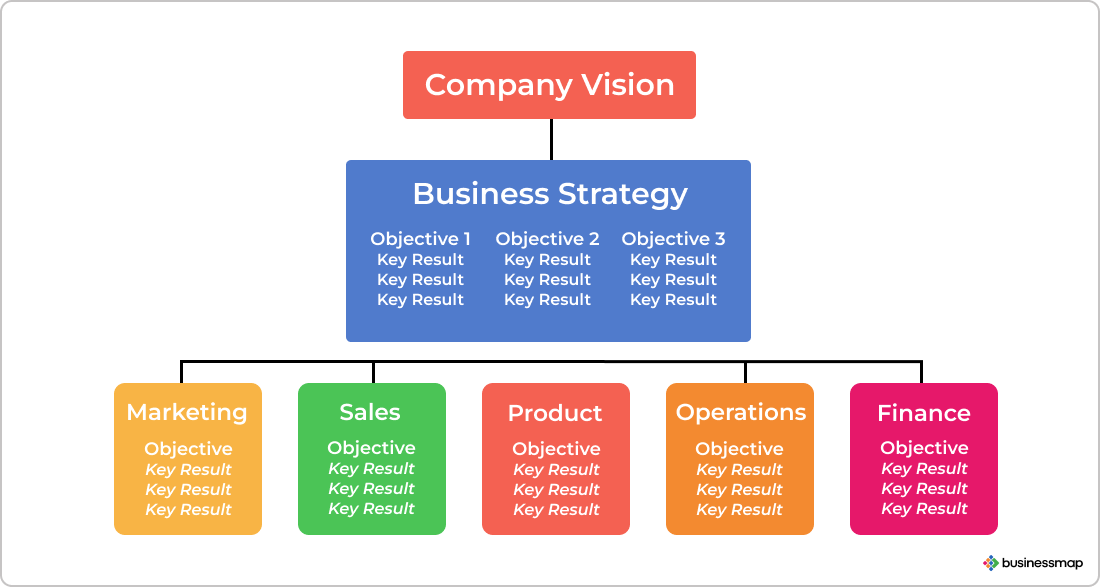Objectives and Key Results is a popular framework used for setting goals in organizations. A key purpose of the OKR is to align the company's strategic goals with team goals to create a unified vision of success.
Objectives are more ambitious and even visionary, whereas Key Results are more numeric and measurable. The hierarchical structure of OKRs ensures the alignment between company plans and work execution. OKR is a way to achieve transparency across the organization.
Setting OKRs and implementing them are two flexible and adjustable processes. In practice, however, a few OKR best practices will ensure that all teams have an unambiguous and focused set of goals to aim for.
Before writing your OKR, you need to understand its nature. OKR has two main characteristics - structure and philosophy.
OKR Structure
When creating OKRs for your company, you have to answer the following two questions below.
- What direction do we want to take the company (our goals)?
- How will we achieve this (through measurable steps)?
When implementing OKR best practices in your company, it's crucial for your team to prioritize two key questions. These questions foster a cascading effect of aligned objectives across the organization, ensuring everyone is informed and in sync with the company's actions.
 Cascading objectives and key results
Cascading objectives and key results
OKR Philosophy
OKR differs from other goal-setting strategies in a few ways. One characteristic is that they are ambitious in nature. If your teams and employees achieve all the goals they set, they are playing it safe by setting easy-to-achieve goals.
The goals should also be measurable. Progress should be tracked by tangible milestones based on the goals. OKRs should also be transparent. Individuals' OKRs should be visible to all members of the organization. Furthermore, the framework aims at improving performance rather than evaluating employees’ performance.
How Two of The Largest Organizations in the World Save Time & Money with OKRs?
Best Practices for Writing OKR Goals
We will explain the best practices for writing a company’s OKR goals.
Best Practices for Writing Objectives
This is a list of the best practices for writing Objectives.
- Defining organizational objectives is the first step. These are the top strategic objectives that require collaboration and connection between various departments and teams across the organization.
- Every department and team in the organization should have three to five objectives. Having too many objectives distracts you from achieving the important ones.
- Objectives have to be actionable and ambitious. These are stretch goals, and the effort to achieve them should make you feel uncomfortable like you are about to do parallel parking for the first time next to a Bugatti (hint, they aren’t the cheapest cars, is it getting uncomfortable already?).
- It is recommended that each Objective has three to five Key Results. When combined, the Key Results must help achieve the Objective.
Best Practices for Writing Key Results
The following are some of the best practices for writing Key Results.
- There should be 3 Key Results per Objective.
- The key results should all be measurable.
- Align the entire OKR process across the organization. Team objectives, for example, can be easily aligned with company objectives. The CEO's Key Results may become the objectives of the VPs within various teams.
- Each team and individual should create at least 40% of their OKRs. At every level, a mix of top-down and bottom-up OKRs promotes employees' innovation and engagement.
Best Practices for Implementing OKRs
Let’s discuss 10 of the best practices for implementing OKRs on all levels within an organization.
1. Get Buy-in from All Participants
OKRs may be used by executives, departments, or by all employees. No matter which approach your organization decides to choose, you need buy-in from all participants. Successful communication begins with why you want to use OKRs, and how OKRs will support the growth of the company. Explain how the company’s OKRs are aligned with individual and department’s OKRs.
Next, everyone should review the proposed OKRs together to ensure they are reasonable and meaningful. Each department leader should discuss individual OKRs with their team members, and the leadership team should review the OKRs with the department heads.
2. Align Team OKRs with Company Objectives
OKR planning often inspires people to come up with new ideas. It's important, however, not to forget the reason why you set OKRs, which is to align team and company goals.
Ensure that most of the team OKRs are related to the company’s objectives. Specific OKR software offers a hierarchy view of OKRs to help you visualize your organizational goals in an easy-to-remember format.
3. Have Leadership Support and an OKR Champion
OKR programs require executive support and a champion. A team can be made up of different roles, but the OKR champion is crucial for holding everyone accountable for achieving OKRs. The role of an OKR champion is similar to that of a Black Belt in Six Sigma, and their support is integral to the successful implementation of OKRs.
4. Be Transparent about Your OKRs
Share OKRs with employees so that they understand the company's focus areas, their team's focus areas, and the impact that they have on the strategic OKRs. As a result, employees become more invested in achieving their own OKRs.
5. Educate and Include Everyone in the OKRs Process
The success of OKRs in an organization will depend on educating everyone and including them in the process. It is crucial to conduct training across all levels of the organization prior to the start of the first OKR cycle, including OKR workshops for team leads.
Integrating weekly updates into the OKR process and maintaining transparency will keep teams aligned and enable them to anticipate potential issues and roadblocks.
6. Begin with a Small Number of Clearly Defined Objectives
Prioritize up to 5 OKRs that your organization wants to achieve for the year.
Inspiration can be found in your mission and vision statement, as well as in current challenges. For instance, you may choose only to sell one specific product or double your revenue. Each department and individual should have three to five goals.
7. Prioritize Goals over Initiatives
OKRs should not be treated as tasks. Defining the desired outcomes helps you identify the initiatives you need to achieve the OKRs. Try not to overspecify. In the event that new information becomes available down the line, a “waterfall” plan at the beginning of the process will stifle creativity and innovation. Though initiatives are connected to OKRs and assist in their completion, they are often tracked separately.
8. Let Employees Participate in Setting Their Own OKRs
Allow employees to define their own OKRs in order to foster autonomy and ownership. By doing this, employees can work on projects they are interested in, use their skills to their best advantage, and grow professionally. By working with their managers, they can ensure that department and company OKRs are aligned and that the company’s needs are met.
9. Hold a Team OKR Weekly Check-In
Regularly, team members should be setting new weekly plans and update the team's Key Results.
An OKR check-in is an opportunity for the team to review each team member's weekly plans and ensure their completion. In this short meeting, usually lasting no longer than 20 minutes, you can also agree on what you need to accomplish next week to advance your OKRs.
10. Report Progress Regularly
Reporting progress on OKRs and discussing roadblocks should be part of regular manager check-ins. The information can be used to track how each team’s OKRs are impacting the progress of departmental and company OKRs.
Each individual in the company needs to be held accountable for their role in achieving OKRs. Review your progress at the end of your time-box (OKR cadence) and make any necessary adjustments for your next set of OKRs.
Businessmap is the most flexible software
to align work with company goals
In Summary
Understanding how to set and implement OKRs through best practices ensures company-wide adoption and clarity about the organizational goals. Some of the best approaches to OKRs implementation include:
- Get buy-in from all participants
- Align team OKRs with company objectives
- Have leadership support and an OKR champion





 Cascading objectives and key results
Cascading objectives and key results


